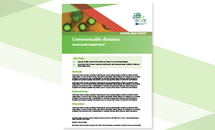Invasive meningococcal disease - Annual Epidemiological Report for 2022
In 2022, 1 149 confirmed cases of invasive meningococcal disease (IMD), including 110 deaths, were reported in 30 European Union/European Economic Area Member States.
Executive Summary
- In 2022, the notification rate of IMD rose to 0.3 cases per 100 000 population, following a decline of the IMD incidence in 2020 and in 2021.
- Age-specific rates were highest in infants aged <1 year, followed by 1–4-year-olds and 15–24-year-olds.
- Serogroup B remains the major cause of IMD; it accounted for 62% of serogroup documented cases overall and was the dominating serogroup in all age groups below 65 years. The notification rate of serogroup B returned to that observed in 2018–19 or below in all age groups except for adolescents aged 15–24 years, where it increased beyond that observed in 2018–19.
- Serogroup Y was the second highest serogroup documented among cases (16%). It was the most reported documented serogroup in those aged 65 years and above, causing 46% of cases in this age group. The notification rate of serogroup Y of 2022 by age group never exceeded the level observed in 2018–19; however, it increased sharply in all age groups except in 25–49-year-olds compared to the level observed in 2021.
- Serogroup W was the third reported cause of IMD in 10% of documented serogroup cases, with the fourth cause being serogroup C (6%). The notification rate of serogroup C has continued to decrease since 2018.
- Case fatality was the highest among cases of serogroup W (17%) and C (20%).
- The continued strengthening of disease surveillance for IMD is essential to evaluate the impact of ongoing immunisation programmes and support decision-makers concerning the implementation or adaptation of vaccination strategies in the lifelong immunisation course.
Download

Invasive meningococcal disease Annual Epidemiological Report for 2022
- EN - [PDF-2.27 MB]







